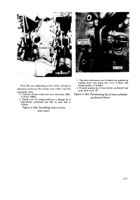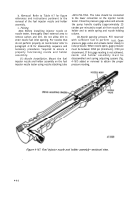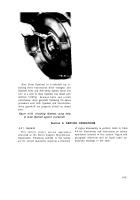TM-9-2815-200-35
ENGINE, WITH CONTAINER:TURBOSUPERCHARGED, DIESEL ,FUEL INJECTION ,90-DEGREE “V” TYPE, AIR - COOLED ,12 - CYLINDER , ASSEMBLY ;MODELS AVDS-1790-2M (2815-856-4996), AVDS-1790-2A AND AVDS-1790-2AM (2815-856-9005)
TECHNICAL MANUAL; DIRECT SUPPORT, GENERAL SUPPORT AND DEPOT MAINTENANCE MANUAL INCLUDING REPAIR PARTS AND SPECIAL TOOLS LISTS
TM-9-2815-200-35 - Page 168 of 779
b. Cleaning.
Note.
D
O
not remove carbon from the valve,
(K-2, figure 4-170), or inner surface of nozzle
body (K-1 )with a sharp tool, abrasive material, or
steel wire brush,
as these implements and
materials will severely damage the highly
polished surfaces.
(1) Fuel injector nozzle assembly.
Soa k
nozzle body in carbon removing solvent to
remove
major
carbon
deposits. Remaining
carbon deposits should be removed using a soft
cloth or felt pad and mutton tallow. A piece of
soft wood, soaked in oil may also be used as a
carbon remover.
(2) Nozzle body spray orifices.
Clea n
carbon from the orifices of the nozzle body by
soaking nozzle body in a carbon removing
solvent only. Do not attempt to clean orifices
with cleaning wire as this method will distort
nozzle orifices and also may block opening due to
wire breakage. It is difficult and often impossible
to remove broken pieces of wire.
(3) Fuel injector
holder and associated
parts.
Clean all parts thoroughly. Be sure hands
are kept free from accumulation of grease which
will cause collection of dust and grit on parts.
Cover or wrap all parts after cleaning to protect
them from dirt accumulation.
c. Inspection.
(1) Nozzle body and valve.
Inspect seat of
nozzle valve (K-2. fig. 4-170) for evidence of
wear, distortion of the valve seat due to pound-
ing,
discoloration due to overheating, and
pitting. Inspect the valve stem between seal and
shoulder for scratches and discoloration. Check
fit of valve in nozzle body by lifting the valve
about one-third of its length out of the body. The
valve should slide back to its seat without aid
when the assembly is held at a 45 degree angle.
Mark sticking assemblies for repair. Inspect the
eight spray orifices in the nozzle body tip and the
drilled passage in the body for freedom of ob-
structions,
Inspect lapped sealing surface of
valve body for scratches, discoloration, and
cracks. Inspect nozzle body valve seat, using a
strong light and a magnifying glass (5 to 7 power
magnification
minimum)
for
scratches,
discoloration, wear, pitting, and evidence of
pounding.
Note.
An
otoscope,
such
as
used
by
physicians for examination of the inner ear, is
well suited for this purpose.
(2) Valve stop spacers.
Inspect the lapped
sealing surfaces on the ends of the valve stop
spacer (L) for scratches, discoloration, and
cracks. Inspect the area around the center hole
on the nozzle end for evidence of wear and
pounding by the nozzle valve. Maximum
allowable depth of wear or pounding at this area
is 0.003-inch. Inspect drilled passages in spacer
for obstructions.
(3) Adjusting spring and spring seats.
Inspect the nozzle opening pressure adjusting
spring (N) and spring upper and lower seats (D
and M) for cracks and evidence of wear.
(4)
Holder spring. Inspect holder spring (P)
for cracks, and for evidence of discoloration due
to excessive heat. Inspect free length of holder
spring. Limit should be from 1.403 to 1.409-inch
when the new copper gasket, FSN 5310-861-
1406, is used. If the old copper-asbestos gasket is
used the limit should be 1.407 to 1.409-inch.
(5) Holder body.
Inspect the holder body
(A) for cracks, burs, nicks, and raised metal.
Inspect lapped sealing surface for scratches and
discoloration. Inspect the threaded area and
tapped
openings
for stripped or damaged
threads.
(6) Nozzle cap nut.
Inspect the nozzle cap
nut (J) for nicks, burs, raised metal surfaces, and
for cracks due to overheating. Inspect threaded
area inside nut for stripped or damaged threads.
Inspect the gasket area on end of nut for deep
scratches.
(7) Nozzle retainer.
Inspect the nozzle
retainer (F) for cracks, nicks, burs, and raised
metal, and for rounding of the hexagon nut area.
Inspect threaded area for stripped or damaged
threads,
(8) Fuel injector tube connector.
Inspect the
fuel injector tube connector(Q) for cracks and for
stripped or damaged threads.
d. Repair.
(1) Nozzle body and valve.
(a) Replace nozzle body (K-1, figure 4-
170) and nozzle valve (K-2) when body seat or
valve seat is badly worn, pounded, or pitted, or
when nozzle does not conform to spray pattern
limits specified in paragraph 4-17c(3). Minor
discoloration or imperfections of body and valve
seat can be cleaned up by lapping the valve into
the body. Clamp valve by its stem in jaws of
rotating chuck. Place a very minute quantity of
fine lapping compound on tip of valve. Slide
4-86
Back to Top




















